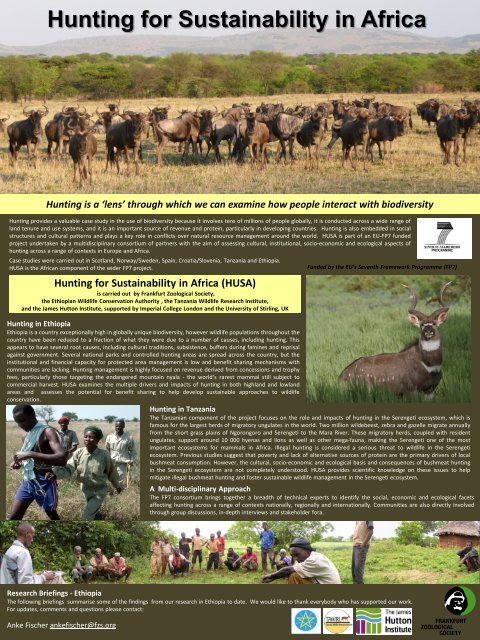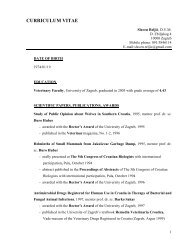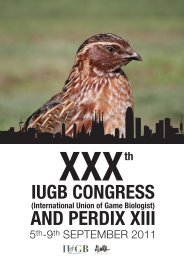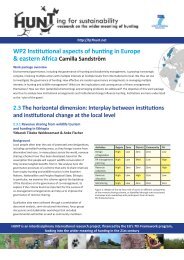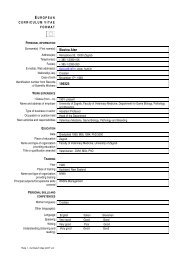Hunting for Sustainability in Africa
Hunting for Sustainability in Africa
Hunting for Sustainability in Africa
You also want an ePaper? Increase the reach of your titles
YUMPU automatically turns print PDFs into web optimized ePapers that Google loves.
<strong>Hunt<strong>in</strong>g</strong> <strong>for</strong> <strong>Susta<strong>in</strong>ability</strong> <strong>in</strong> <strong>Africa</strong><br />
<strong>Hunt<strong>in</strong>g</strong> <strong>for</strong> <strong>Susta<strong>in</strong>ability</strong> <strong>in</strong> <strong>Africa</strong> – Ethiopia Research Brief<strong>in</strong>gs<br />
<strong>Hunt<strong>in</strong>g</strong> is a ‘lens’ through which we can exam<strong>in</strong>e how people <strong>in</strong>teract with biodiversity<br />
<strong>Hunt<strong>in</strong>g</strong> provides a valuable case study <strong>in</strong> the use of biodiversity because it <strong>in</strong>volves tens of millions of people globally, it is conducted across a wide range of<br />
land tenure and use systems, and it is an important source of revenue and prote<strong>in</strong>, particularly <strong>in</strong> develop<strong>in</strong>g countries. <strong>Hunt<strong>in</strong>g</strong> is also embedded <strong>in</strong> social<br />
structures and cultural patterns and plays a key role <strong>in</strong> conflicts over natural resource management around the world. HUSA is part of an EU-FP7 funded<br />
project undertaken by a multidiscipl<strong>in</strong>ary consortium of partners with the aim of assess<strong>in</strong>g cultural, <strong>in</strong>stitutional, socio-economic and ecological aspects of<br />
hunt<strong>in</strong>g across a range of contexts <strong>in</strong> Europe and <strong>Africa</strong>.<br />
Case studies were carried out <strong>in</strong> Scotland, Norway/Sweden, Spa<strong>in</strong>, Croatia/Slovenia, Tanzania and Ethiopia.<br />
HUSA is the <strong>Africa</strong>n component of the wider FP7 project.<br />
<strong>Hunt<strong>in</strong>g</strong> <strong>for</strong> <strong>Susta<strong>in</strong>ability</strong> <strong>in</strong> <strong>Africa</strong> (HUSA)<br />
is carried out by Frankfurt Zoological Society,<br />
the Ethiopian Wildlife Conservation Authority , the Tanzania Wildlife Research Institute,<br />
and the James Hutton Institute, supported by Imperial College London and the University of Stirl<strong>in</strong>g, UK<br />
<strong>Hunt<strong>in</strong>g</strong> <strong>in</strong> Ethiopia<br />
Ethiopia is a country exceptionally high <strong>in</strong> globally unique biodiversity, however wildlife populations throughout the<br />
country have been reduced to a fraction of what they were due to a number of causes, <strong>in</strong>clud<strong>in</strong>g hunt<strong>in</strong>g. This<br />
appears to have several root causes, <strong>in</strong>clud<strong>in</strong>g cultural traditions, subsistence, buffers dur<strong>in</strong>g fam<strong>in</strong>es and reprisal<br />
aga<strong>in</strong>st government. Several national parks and controlled hunt<strong>in</strong>g areas are spread across the country, but the<br />
<strong>in</strong>stitutional and f<strong>in</strong>ancial capacity <strong>for</strong> protected area management is low and benefit shar<strong>in</strong>g mechanisms with<br />
communities are lack<strong>in</strong>g. <strong>Hunt<strong>in</strong>g</strong> management is highly focused on revenue derived from concessions and trophy<br />
fees, particularly those target<strong>in</strong>g the endangered mounta<strong>in</strong> nyala - the world’s rarest mammal still subject to<br />
commercial harvest. HUSA exam<strong>in</strong>es the multiple drivers and impacts of hunt<strong>in</strong>g <strong>in</strong> both highland and lowland<br />
areas and assesses the potential <strong>for</strong> benefit shar<strong>in</strong>g to help develop susta<strong>in</strong>able approaches to wildlife<br />
conservation.<br />
Funded by the EU’s Seventh Framework Programme (FP7)<br />
<strong>Hunt<strong>in</strong>g</strong> <strong>in</strong> Tanzania<br />
The Tanzanian component of the project focuses on the role and impacts of hunt<strong>in</strong>g <strong>in</strong> the Serengeti ecosystem, which is<br />
famous <strong>for</strong> the largest herds of migratory ungulates <strong>in</strong> the world. Two million wildebeest, zebra and gazelle migrate annually<br />
from the short grass pla<strong>in</strong>s of Ngorongoro and Serengeti to the Mara River. These migratory herds, coupled with resident<br />
ungulates, support around 10 000 hyenas and lions as well as other mega-fauna, mak<strong>in</strong>g the Serengeti one of the most<br />
important ecosystems <strong>for</strong> mammals <strong>in</strong> <strong>Africa</strong>. Illegal hunt<strong>in</strong>g is considered a serious threat to wildlife <strong>in</strong> the Serengeti<br />
ecosystem. Previous studies suggest that poverty and lack of alternative sources of prote<strong>in</strong> are the primary drivers of local<br />
bushmeat consumption. However, the cultural, socio-economic and ecological basis and consequences of bushmeat hunt<strong>in</strong>g<br />
<strong>in</strong> the Serengeti ecosystem are not completely understood. HUSA provides scientific knowledge on these issues to help<br />
mitigate illegal bushmeat hunt<strong>in</strong>g and foster susta<strong>in</strong>able wildlife management <strong>in</strong> the Serengeti ecosystem.<br />
A Multi-discipl<strong>in</strong>ary Approach<br />
The FP7 consortium br<strong>in</strong>gs together a breadth of technical experts to identify the social, economic and ecological facets<br />
affect<strong>in</strong>g hunt<strong>in</strong>g across a range of contexts nationally, regionally and <strong>in</strong>ternationally. Communities are also directly <strong>in</strong>volved<br />
through group discussions, <strong>in</strong>-depth <strong>in</strong>terviews and stakeholder <strong>for</strong>a.<br />
Research Brief<strong>in</strong>gs - Ethiopia<br />
The follow<strong>in</strong>g brief<strong>in</strong>gs summarise some of the f<strong>in</strong>d<strong>in</strong>gs from our research <strong>in</strong> Ethiopia to date. We would like to thank everybody who has supported our work.<br />
For updates, comments and questions please contact:<br />
Anke Fischer ankefischer@fzs.org
<strong>Hunt<strong>in</strong>g</strong> <strong>for</strong> <strong>Susta<strong>in</strong>ability</strong> <strong>in</strong> <strong>Africa</strong> – Ethiopia Research Brief<strong>in</strong>gs<br />
Revenue shar<strong>in</strong>g from wildlife tourism and hunt<strong>in</strong>g<br />
Background<br />
• Local people often bear the cost of protected area designations, <strong>in</strong>clud<strong>in</strong>g controlled hunt<strong>in</strong>g areas, as<br />
they <strong>for</strong>ego <strong>in</strong>come from alternative land uses<br />
• In many places across the world, revenue shar<strong>in</strong>g schemes have thus been developed, based on the<br />
assumption that people will support wildlife conservation if they receive tangible benefits from it<br />
• We analyse here the governance processes of a scheme that aims to share revenues from trophy hunt<strong>in</strong>g<br />
and wildlife tourism <strong>in</strong> the Southern Nations, Nationalities and Peoples Regional State, Ethiopia<br />
• Qualitative data was collected through a comb<strong>in</strong>ation of document analysis, semi-structured <strong>in</strong>terviews,<br />
focus group discussions and stakeholder workshops that <strong>in</strong>cluded governmental authorities as well as<br />
community members<br />
Key f<strong>in</strong>d<strong>in</strong>gs<br />
• All study participants welcomed the scheme and saw it as<br />
work <strong>in</strong> progress. Four areas of the current legislation and<br />
implementation practice were seen to require improvement:<br />
– In<strong>for</strong>mation on the detail of the scheme was lack<strong>in</strong>g<br />
among many actors<br />
– Roles and responsibilities of the actors were imbalanced –<br />
district governments were very <strong>in</strong>fluential whereas local<br />
communities tended to be passive<br />
– Accountability was compromised, as limited provisions<br />
had been made <strong>for</strong> monitor<strong>in</strong>g and evaluation<br />
– Disbursement of the shares was usually not associated to<br />
hunt<strong>in</strong>g or tourism, and overall revenue was too limited<br />
to have an impact<br />
Conclusions<br />
Region<br />
Zone<br />
Districts<br />
Communities<br />
Protected Areas<br />
Fig.: In<strong>for</strong>mation flows between actors. Thicker l<strong>in</strong>es denote<br />
more frequent communication.<br />
• The revenue shar<strong>in</strong>g scheme was established <strong>in</strong> 2007, and it was thus too early to assess its impacts<br />
on conservation-related attitudes and behaviour. Our analysis of governance processes now <strong>in</strong><strong>for</strong>ms<br />
the government’s current revision of legislation and implementation practice<br />
• It seems unlikely that the scheme will lead to attitude and behaviour change among the local<br />
population <strong>in</strong> the future, given the miss<strong>in</strong>g connection between conservation-relevant behaviours<br />
and the amount of revenue distributed. This might be addressed by a turn towards co-management<br />
of the protected areas, where responsibility <strong>for</strong> wildlife is shared between government and local<br />
communities<br />
• However, at a political level, <strong>for</strong>malised revenue shar<strong>in</strong>g as <strong>in</strong> this scheme might help to make the<br />
monetary value of wildlife conservation visible, thus provid<strong>in</strong>g arguments aga<strong>in</strong>st land conversion<br />
Contact: Yitbarek Tibebe yitbarektibebe@fzs.org May 2012<br />
1/5
<strong>Hunt<strong>in</strong>g</strong> <strong>for</strong> <strong>Susta<strong>in</strong>ability</strong> <strong>in</strong> <strong>Africa</strong> – Ethiopia Research Brief<strong>in</strong>gs<br />
The role of women <strong>in</strong> hunt<strong>in</strong>g <strong>in</strong> lower Omo, Ethiopia<br />
Background<br />
• <strong>Hunt<strong>in</strong>g</strong> without a permit is illegal <strong>in</strong> Ethiopia. Partly due to such uncontrolled hunt<strong>in</strong>g, wildlife<br />
populations <strong>in</strong> many areas, <strong>in</strong>clud<strong>in</strong>g southern Ethiopia, have decl<strong>in</strong>ed substantially <strong>in</strong> recent years.<br />
Illegal hunt<strong>in</strong>g is thus a major conservation concern<br />
• <strong>Hunt<strong>in</strong>g</strong> by local residents of the lower Omo valley <strong>in</strong> southern Ethiopia, such as the Hamar, Mursi or<br />
Arbore, has received comparatively little academic attention, but is often portrayed as a male activity,<br />
focus<strong>in</strong>g on large game, connected to bravery and manhood<br />
• To provide <strong>in</strong>sights <strong>in</strong>to the cultural and social context of illegal<br />
hunt<strong>in</strong>g <strong>in</strong> lower Omo, we explore here the role of women<br />
Method<br />
• We analysed qualitative data from focus group discussions and<br />
<strong>in</strong>terviews <strong>in</strong> 7 villages (n=105 participants) <strong>in</strong>habited by Hamar,<br />
Bashada, Kara and Arbore ethnic groups. Separate discussions<br />
were held <strong>for</strong> women<br />
Results<br />
• Women played an important role <strong>in</strong> male hunt<strong>in</strong>g activities by actively encourag<strong>in</strong>g hunt<strong>in</strong>g and<br />
discourag<strong>in</strong>g non-hunt<strong>in</strong>g through a variety of verbal and non-verbal means. These <strong>in</strong>cluded, e.g., …<br />
– Ritualised activities: welcom<strong>in</strong>g a successful first-time hunter with symbolic gifts, songs and a<br />
ceremony<br />
– Preference <strong>for</strong> successful hunters as partners, and withdrawal of affection from non-hunt<strong>in</strong>g men<br />
– Praise <strong>for</strong> hunters, and <strong>in</strong>sults and explicit disregard of non-hunters<br />
• Non-hunt<strong>in</strong>g men were portrayed as a category <strong>in</strong> between ‘man’ and ‘woman’<br />
“Dur<strong>in</strong>g the danc<strong>in</strong>g, dur<strong>in</strong>g the songs, the girls will not choose the<br />
one who didn’t kill a buffalo. They choose only the killer.” (Man, age 50)<br />
Conclusions<br />
• Overall, female behaviours <strong>in</strong> relation to male hunt<strong>in</strong>g were very diverse and ritualised. However, the<br />
stark decl<strong>in</strong>e <strong>in</strong> wildlife meant that such rituals would nowadays only rarely be carried out<br />
• Still, hunt<strong>in</strong>g of large game has high cultural importance <strong>in</strong> lower Omo. It both contributes to and is<br />
encouraged by the def<strong>in</strong>ition of gender roles<br />
• Conservation <strong>in</strong>terventions that aim to address illegal hunt<strong>in</strong>g of large game need to consider<br />
<strong>in</strong>teractions between genders <strong>in</strong> order to be successful<br />
Contact: Degu Tadie degutadie@fzs.org May 2012<br />
2/5
<strong>Hunt<strong>in</strong>g</strong> <strong>for</strong> <strong>Susta<strong>in</strong>ability</strong> <strong>in</strong> <strong>Africa</strong> – Ethiopia Research Brief<strong>in</strong>gs<br />
<strong>Hunt<strong>in</strong>g</strong>, social structure and human-nature relationships<br />
Background<br />
• <strong>Hunt<strong>in</strong>g</strong> has often been portrayed as the ultimate <strong>for</strong>m of human-wildlife<br />
<strong>in</strong>teraction, emphasis<strong>in</strong>g the close connection between hunter and game<br />
• In southern Ethiopia, illegal hunt<strong>in</strong>g, usually described as a culturally<br />
important activity, is a conservation concern, due to stark decl<strong>in</strong>es <strong>in</strong><br />
wildlife populations<br />
• Can a better understand<strong>in</strong>g of the human-wildlife relationships enacted<br />
through hunt<strong>in</strong>g help us to address conservation concerns related to illegal<br />
hunt<strong>in</strong>g <strong>in</strong> the lower Omo valley, Ethiopia?<br />
• To address this question, we analysed qualitative data from focus group<br />
discussions and <strong>in</strong>terviews <strong>in</strong> 7 villages (n=105 participants), <strong>in</strong>habited by<br />
Hamar, Bashada, Kara and Arbore ethnic groups<br />
Key f<strong>in</strong>d<strong>in</strong>gs<br />
• <strong>Hunt<strong>in</strong>g</strong> helped people to develop and ma<strong>in</strong>ta<strong>in</strong> social structures beyond family bonds. <strong>Hunt<strong>in</strong>g</strong> of large<br />
game was central to the establishment of long-term relationships between two hunt<strong>in</strong>g friends (called<br />
misso) and between a successful first-time hunter and a girl, his ‘honorary elder sister’ (called misha).<br />
Misso and misha relationships could be seen as social capital which could be drawn on <strong>in</strong> difficult times<br />
• By contrast, hunt<strong>in</strong>g seem to hold very little mean<strong>in</strong>g <strong>for</strong> the hunters’ relationship to wildlife or nature.<br />
Study participants had recently experienced dramatic degradation of their environment (e.g.,<br />
disappearance of wildlife, lack of graz<strong>in</strong>g <strong>for</strong> livestock), but seemed to accept these changes <strong>in</strong> an almost<br />
fatalistic manner. Attempts to understand and expla<strong>in</strong> these changes were limited<br />
Conclusions<br />
“The girl will see<br />
him and say: ‘He is<br />
the hunter’, and<br />
run towards him<br />
and put her<br />
necklaces on him;<br />
she is called<br />
misha.”<br />
(Man, age 40)<br />
“We are worried about it. We don’t know; maybe the land turned upside<br />
down and brought up the soil, which we have never seen be<strong>for</strong>e. The land<br />
is bare; this is new <strong>for</strong> us. The cattle are there, the goats are there, but we<br />
don’t know whether they will be saved or perish. We are just here because<br />
we are born here and have nowhere to go.” Man, age 55<br />
• Overall, <strong>in</strong> lower Omo, hunt<strong>in</strong>g was important to establish relationships between people, but did not seem<br />
relevant <strong>for</strong> develop<strong>in</strong>g relationships with nature or wildlife, or knowledge about the natural environment.<br />
Ironically, this strong focus on social relations might contribute to the disappearance of hunt<strong>in</strong>g and its<br />
social functions<br />
• The social importance of resource use practices (such as hunt<strong>in</strong>g), human-nature relationships and the<br />
ways how knowledge about the environment is acquired need to be understood to create a mean<strong>in</strong>gful<br />
basis <strong>for</strong> conservation and development <strong>in</strong>terventions. Contact: degutadie@fzs.org May 2012<br />
3/5
<strong>Hunt<strong>in</strong>g</strong> <strong>for</strong> <strong>Susta<strong>in</strong>ability</strong> <strong>in</strong> <strong>Africa</strong> – Ethiopia Research Brief<strong>in</strong>gs<br />
Trophy hunt<strong>in</strong>g and conservation of mounta<strong>in</strong> nyala<br />
Background<br />
• The mounta<strong>in</strong> nyala (Tragelaphus buxtoni) is an endangered antelope that is endemic to Ethiopia with<br />
an estimated population size around 4000. It is trophy hunted <strong>for</strong> its large spiralled horns<br />
• Trophy hunt<strong>in</strong>g has the potential to support conservation of trophy species and wider biodiversity<br />
• However, mak<strong>in</strong>g decisions to benefit species, habitats and people is challeng<strong>in</strong>g because priorities<br />
differ between <strong>in</strong>terest groups, but also because of a lack of <strong>in</strong><strong>for</strong>mation on key components of the<br />
system, such as mounta<strong>in</strong> nyala population sizes<br />
Method<br />
• We used a new modell<strong>in</strong>g method that facilitates decision mak<strong>in</strong>g when there is limited <strong>in</strong><strong>for</strong>mation<br />
and diverg<strong>in</strong>g objectives. This approach is widely used <strong>in</strong> fisheries and explicitly lays out the trade-offs<br />
<strong>in</strong>volved <strong>in</strong> different policies, so that decision-makers can act with a clearer understand<strong>in</strong>g of<br />
uncerta<strong>in</strong>ties and consequences associated to these policies<br />
Key f<strong>in</strong>d<strong>in</strong>gs<br />
• The quality and quantity of <strong>in</strong><strong>for</strong>mation available to decisionmakers<br />
determ<strong>in</strong>es their ability to make <strong>in</strong><strong>for</strong>med decisions.<br />
Our study on mounta<strong>in</strong> nyala showed that the 10 years of<br />
monitor<strong>in</strong>g data currently available are sufficient to make<br />
<strong>in</strong><strong>for</strong>med decisions<br />
Observation<br />
process<br />
Perceived<br />
Government<br />
model<br />
Quota<br />
• However, robust decision-mak<strong>in</strong>g is currently hampered by<br />
large uncerta<strong>in</strong>ties <strong>in</strong> the precision of population monitor<strong>in</strong>g.<br />
The effects of poach<strong>in</strong>g and habitat loss (from human<br />
encroachment) on the nyala population are unknown<br />
Monitor<strong>in</strong>g<br />
Population<br />
model<br />
Poach<strong>in</strong>g<br />
Local<br />
people<br />
Conclusions<br />
• The proposed framework is transferable and appropriate <strong>for</strong> many small-scale terrestrial systems <strong>in</strong><br />
develop<strong>in</strong>g countries. It is very flexible and easily <strong>in</strong>tegrated <strong>in</strong>to adaptive management<br />
• Our approach can use qualitative and quantitative <strong>in</strong><strong>for</strong>mation (e.g. social, economic and ecological<br />
data) and the full extent of past data (time series)<br />
• Quota sett<strong>in</strong>g <strong>for</strong> mounta<strong>in</strong> nyala should ideally take population trends and past harvest quota <strong>in</strong>to<br />
account . This balances the trade-offs between conservation of mounta<strong>in</strong> nyala, economic profit and<br />
stability better than the commonly used rule of tak<strong>in</strong>g a proportion of the population. Under current<br />
uncerta<strong>in</strong>ties, an adaptive, iterative approach which uses estimates of poach<strong>in</strong>g and habitat loss,<br />
population monitor<strong>in</strong>g and past quotas will most likely lead to higher harvests than the current<br />
management. However, an <strong>in</strong>crease <strong>in</strong> quota will only be susta<strong>in</strong>able if also habitat loss and poach<strong>in</strong>g<br />
are kept at a susta<strong>in</strong>able level<br />
Contact: Nils Bunnefeld n.bunnefeld06@imperial.ac.uk May 2012<br />
4/5
<strong>Hunt<strong>in</strong>g</strong> <strong>for</strong> <strong>Susta<strong>in</strong>ability</strong> <strong>in</strong> <strong>Africa</strong> – Ethiopia Research Brief<strong>in</strong>gs<br />
Summary and recommendations<br />
• The research project “<strong>Hunt<strong>in</strong>g</strong> <strong>for</strong> <strong>Susta<strong>in</strong>ability</strong> <strong>in</strong> <strong>Africa</strong>” <strong>in</strong>vestigated cultural,<br />
<strong>in</strong>stitutional and economic aspects of legal and illegal hunt<strong>in</strong>g <strong>in</strong> Ethiopia. Studies<br />
<strong>in</strong>cluded:<br />
– An assessment of the governance of revenue shar<strong>in</strong>g from hunt<strong>in</strong>g and wildlife<br />
tourism <strong>in</strong> southern Ethiopia<br />
– Cultural factors <strong>in</strong>fluenc<strong>in</strong>g illegal hunt<strong>in</strong>g <strong>in</strong> the lower Omo valley<br />
– A model to identify susta<strong>in</strong>able harvest rates <strong>for</strong> mounta<strong>in</strong> nyala<br />
• Our f<strong>in</strong>d<strong>in</strong>gs from lower Omo suggest that hunt<strong>in</strong>g is deeply embedded <strong>in</strong> the cultural<br />
and social structures of the area. Environmental education campaigns that aim to<br />
reduce hunt<strong>in</strong>g have raised awareness of the <strong>for</strong>mal illegality of hunt<strong>in</strong>g, but not<br />
changed its cultural and social mean<strong>in</strong>g. Despite the disappearance of wildlife from<br />
the area, the social importance of hunt<strong>in</strong>g still prevails and <strong>in</strong><strong>for</strong>ms behaviour. Our<br />
study raises the question if a greater awareness of the social importance of hunt<strong>in</strong>g<br />
and its likely future demise, partly due to overhunt<strong>in</strong>g, might help local people to<br />
develop more susta<strong>in</strong>able hunt<strong>in</strong>g practices – <strong>for</strong> example, to abandon the use of<br />
automatic rifles <strong>for</strong> hunt<strong>in</strong>g<br />
• As it stands, revenue shar<strong>in</strong>g from trophy hunt<strong>in</strong>g and conservation might not have<br />
the <strong>in</strong>tended impact either, as revenue disbursement is not directly coupled to wildlife<br />
populations. As a consequence, the revenue shar<strong>in</strong>g scheme might not <strong>in</strong>fluence<br />
hunt<strong>in</strong>g and e.g., livestock graz<strong>in</strong>g practices. Co-management of protected areas could<br />
be a way to address this. However, any attempts at establish<strong>in</strong>g collaborative<br />
arrangements need to take <strong>in</strong>to account local residents’ ways of knowledge<br />
generation and decision-mak<strong>in</strong>g. Our f<strong>in</strong>d<strong>in</strong>gs – that cannot be presented here <strong>in</strong> full<br />
detail – could be used as a start<strong>in</strong>g po<strong>in</strong>t.<br />
• Additional work, e.g., on tourist hunters’<br />
preferences <strong>for</strong> trophy hunt<strong>in</strong>g <strong>in</strong> Ethiopia, is<br />
underway. These brief<strong>in</strong>gs will be updated<br />
throughout 2012.<br />
Contact: ankefischer@fzs.org June 2012<br />
5/5


